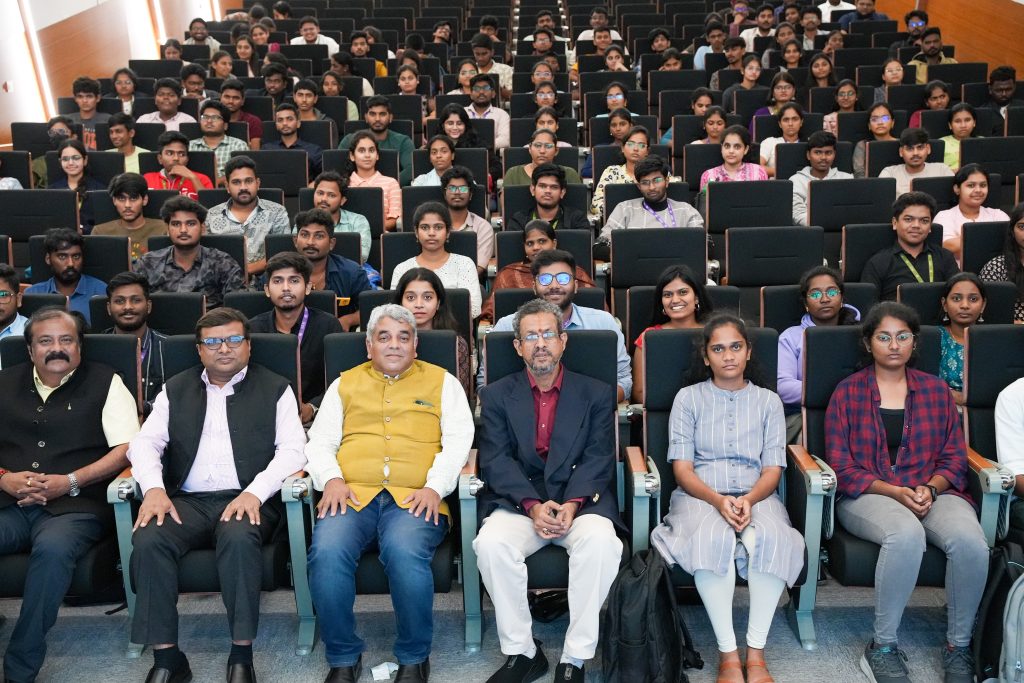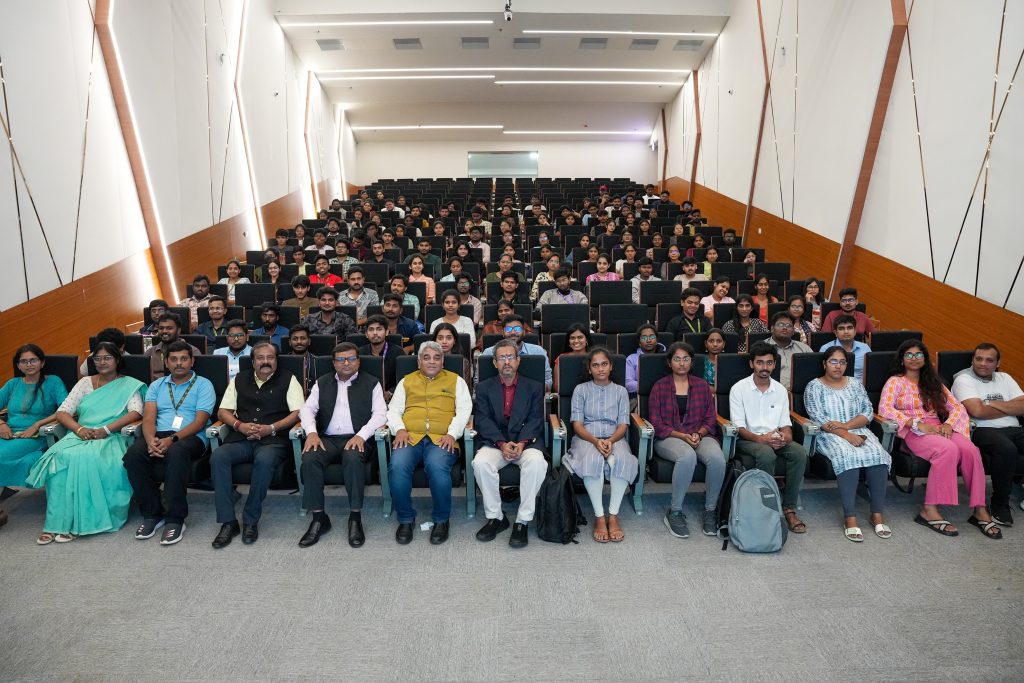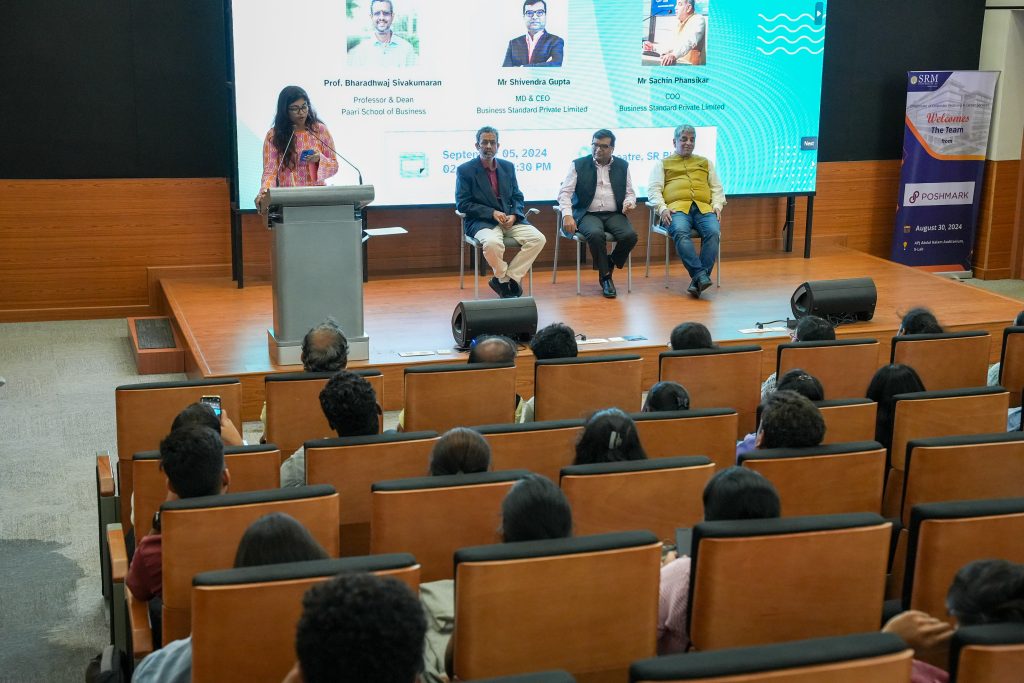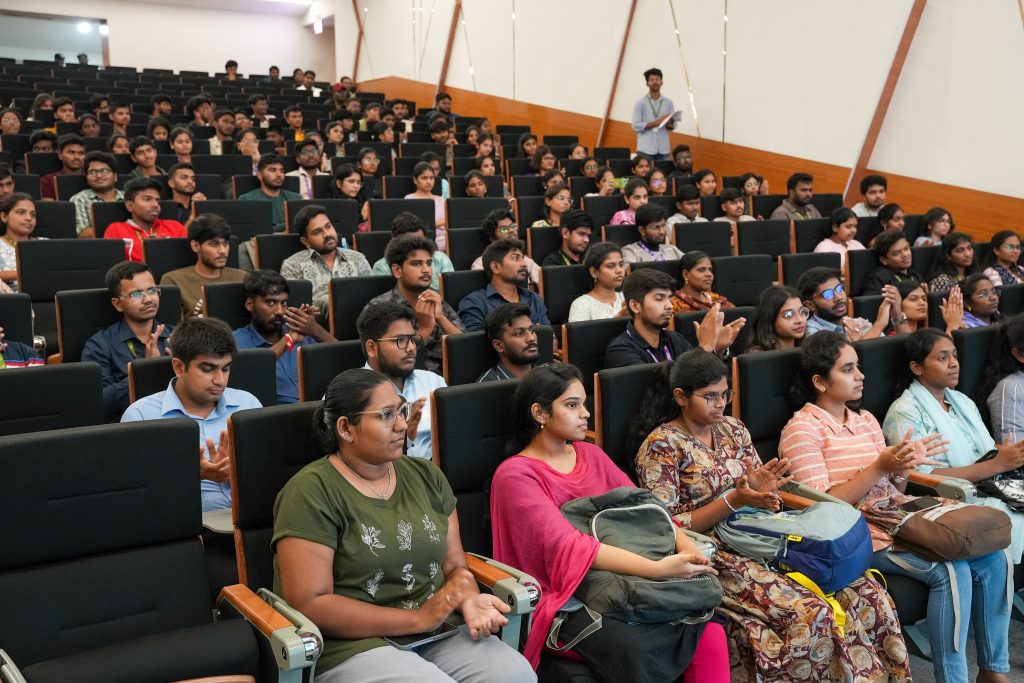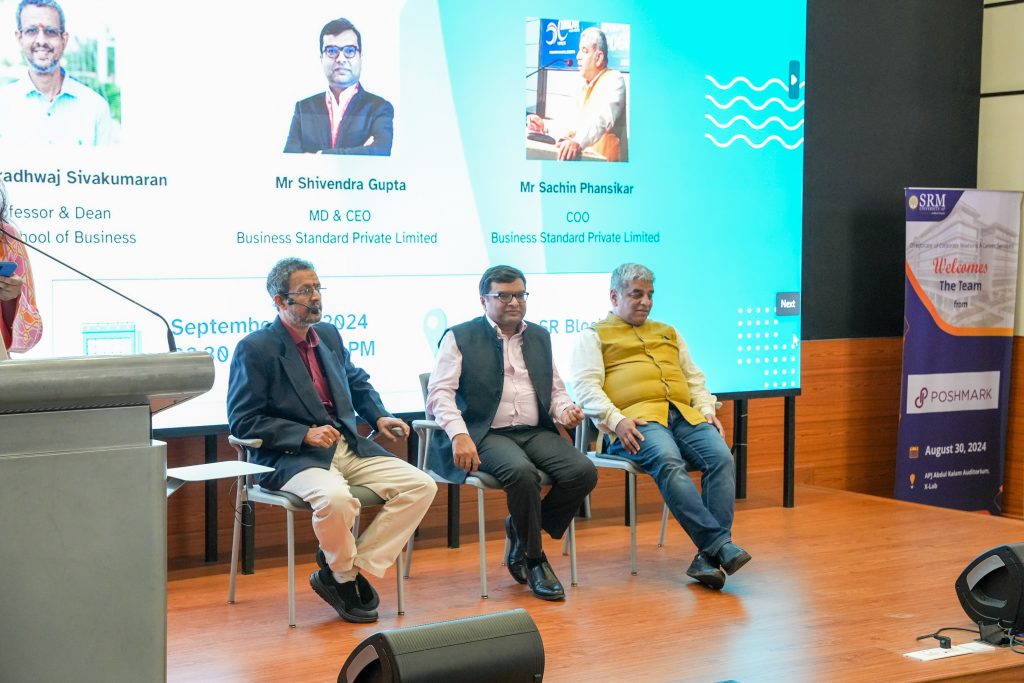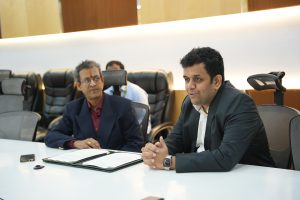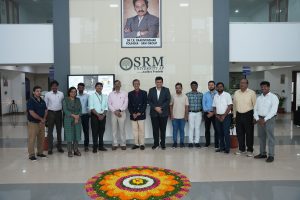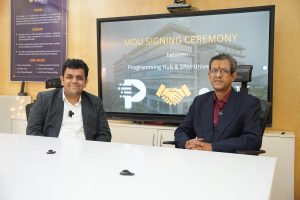SRM-AP All News
ALL News
- Dr Jaidev Kaushik’s Publishes New Publication on Graphene Incorporated Aerogels September 24, 2024
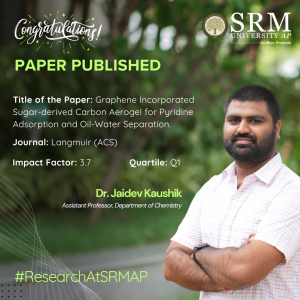 Dr Jaidev Kaushik, an Assistant Professor in the Department of Chemistry, has recently published a pioneering research paper in the prestigious journal Langmuir (ACS). The paper, titled “Graphene Incorporated Sugar-derived Carbon Aerogel for Pyridine Adsorption and Oil-Water Separation,” explores innovative applications of graphene-based materials.
Dr Jaidev Kaushik, an Assistant Professor in the Department of Chemistry, has recently published a pioneering research paper in the prestigious journal Langmuir (ACS). The paper, titled “Graphene Incorporated Sugar-derived Carbon Aerogel for Pyridine Adsorption and Oil-Water Separation,” explores innovative applications of graphene-based materials.Dr Kaushik’s research focuses on the development of a novel carbon aerogel derived from sugar and incorporated with graphene. This material demonstrates exceptional efficiency in adsorbing pyridine, a harmful organic compound, and effectively separating oil from water. These findings hold significant promise for environmental remediation and industrial applications, offering a sustainable solution to pollution and waste management challenges.
The publication of this paper in Langmuir highlights the cutting-edge research being conducted at SRM University-AP and underscores Dr Kaushik’s contributions to the field of chemistry. His work not only advances scientific understanding but also paves the way for practical applications that can benefit society at large.
Abstract
In this report, we have synthesized three-dimensional and hydrophobic graphene-incorporated carbon aerogel (G-SCA) derived from sugar. G-SCA is being used as a multifunctional sorbent material for removing various advanced water soluble and insoluble pollutants Initially, G-SCA is being explored for the adsorption of nitrophenols, nitroaromatics (3-nitroaniline), insecticide (Phoskill), antibiotic (ciprofloxacin), and pharmaceutical drug precursor (pyridine). Later, same G-SCA is also explored in the absorption of various protic and aprotic organic solvents and oils (including crude oil, waste cooking oil, and waste Mobil oil), with excellent recyclability checked up to 10 cycles. Moreover, oil-water separation experiments are also being done in various industrial wastewater samples and seawater to support the real-life accessibility of present approach. Large-scale applicability of G-SCA is also checked by performing crude oil-seawater separation experiments using a laboratory-scale prototype demonstrating the successful continuous recovery of crude oil.
Explanation of The Research in Layperson’s Terms
This research demonstrates the synthesis of carbon aerogel from edible sugar followed by the incorporation of graphene oxide to make a near superhydrophobic and good water-floating sorbent material. Later, this sorbent material was used to decontaminate wastewater from advanced pollutants such as explosive wastes, expired antibiotics, pharmaceutical waste, insecticides, etc. This report also showed the practical demonstration of crude oil recovery from seawater, thus contributing to the circular economy process.
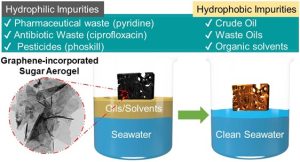
Title of Research Paper in the Citation Format
F. Agrawal, K. Gupta, J. Kaushik, K. M. Tripathi, S. K. Choudhary, S. K. Sonkar, Graphene Incorporated Sugar Derived Carbon Aerogel for Pyridine Adsorption and Oil–Water Separation, Langmuir 2024, 40, 18028–18038.
Practical Implementation or the Social Implications Associated with the Research
This work describes the synthesis of low-cost near superhydrophobic carbon aerogel, displaying its multiple applications in wastewater treatment from water-soluble and water-insoluble pollutants. It is also an alternative and cost-effective approach for recovering valuable oil and organic compounds from water rather than degrading or destroying them so they can be reused.
Collaborations
Dr Sumit Kumar Sonkar (MNIT Jaipur, India)
Future Research Plans
1. The adsorption/photodegradation-assisted quick and efficient removal of next generation advanced pollutants such as microplastic, pesticides, pharmaceutical waste, etc. by hydrophobic carbon aerogel and their doped and functionalised versions.
Continue reading →
2. Utilizing waste derived heterogeneous catalysts in organic transformation reactions.
3. Selective sensing of toxic metal ions/biomarkers/biomolecules using fluorescent nanomaterials.
4. Upcycling of carbonates/CO2 via photo/thermal assisted reactions to get C1 and C2 hydrocarbons (green fuel). - Unveiling Innovations: Dr Ghosh Publishes Findings on 300 GHz Communication Links September 24, 2024
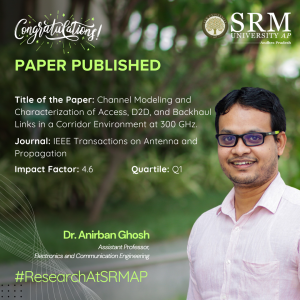 Dr Anirban Ghosh, an esteemed Assistant Professor in the Department of Electronics and Communication Engineering, has recently published a significant research paper titled “Channel Modeling and Characterization of Access, D2D, and Backhaul Links in a Corridor Environment at 300 GHz.” This paper has been featured in the prestigious Q1 Journal, IEEE Transactions on Antenna and Propagation, with an impressive impact factor of 4.6.
Dr Anirban Ghosh, an esteemed Assistant Professor in the Department of Electronics and Communication Engineering, has recently published a significant research paper titled “Channel Modeling and Characterization of Access, D2D, and Backhaul Links in a Corridor Environment at 300 GHz.” This paper has been featured in the prestigious Q1 Journal, IEEE Transactions on Antenna and Propagation, with an impressive impact factor of 4.6.
Dr Ghosh’s research delves into the intricate aspects of channel modelling and characterisation, focusing on access, device-to-device (D2D), and backhaul links within a corridor environment at a high frequency of 300 GHz. This study is poised to make substantial contributions to the field of wireless communication, particularly in enhancing the understanding and development of next-generation communication systems.
The publication in such a renowned journal underscores the quality and impact of Dr. Ghosh’s work, reflecting the cutting-edge research being conducted at SRM University – AP. The university community extends its heartfelt congratulations to Dr. Ghosh for this remarkable achievement and looks forward to his continued contributions to the field of electronics and communication engineering.Abstract:
This paper presents comprehensive double-directional channel measurements at 300 GHz across various corridor scenarios, including Access, Device-to-Device (D2D), and Backhaul, using an in-house developed channel sounder. The measurements, validated by ray tracing simulations, reveal that while 300 GHz quasi-optical propagation in corridors can be modeled using ray optics, non-trivial propagation phenomena, such as quadruple-bounce reflections, also occur. To accurately model these mechanisms, a quasi-deterministic (QD) channel model combining deterministic and random components is proposed. The QD model results align well with observations, highlighting similar propagation mechanisms for Access and D2D scenarios, while Backhaul scenarios show Line-of-Sight (LoS) impacts from ceiling reflections. These findings are crucial for designing next-generation THz communication systems.
Explanation of Research in Layperson’s Terms
This research contributes to building the next generation of communication networks, which will significantly impact society by improving connectivity, supporting technological advancements, and promoting economic development, and bringing forth several futuristic applications.
Practical Implementation
The results align with the design of high-frequency ultra-high speed, low-latency, reliable communication envisioned for several futuristic applications using beyond 5G and 6G networks.

The measurement scenarios explored in the paper.
Collaborations
Prof. Minseok Kim
Professor, Faculty of Engineering, Course of Electrical and Electronics Engineering
Niigata University, Japan.
e-mail: mskim@eng.niigata-u.ac.jpFuture Research Plans
The efforts would be extended to other communication scenarios for a similar study. Additionally, generating appropriate channel models, coverage design, link budget, etc for the explored and unexplored scenarios would also encompass an interesting study.
Continue reading → - Leadership Insights: Navigating the Future with Paari School of Business September 18, 2024
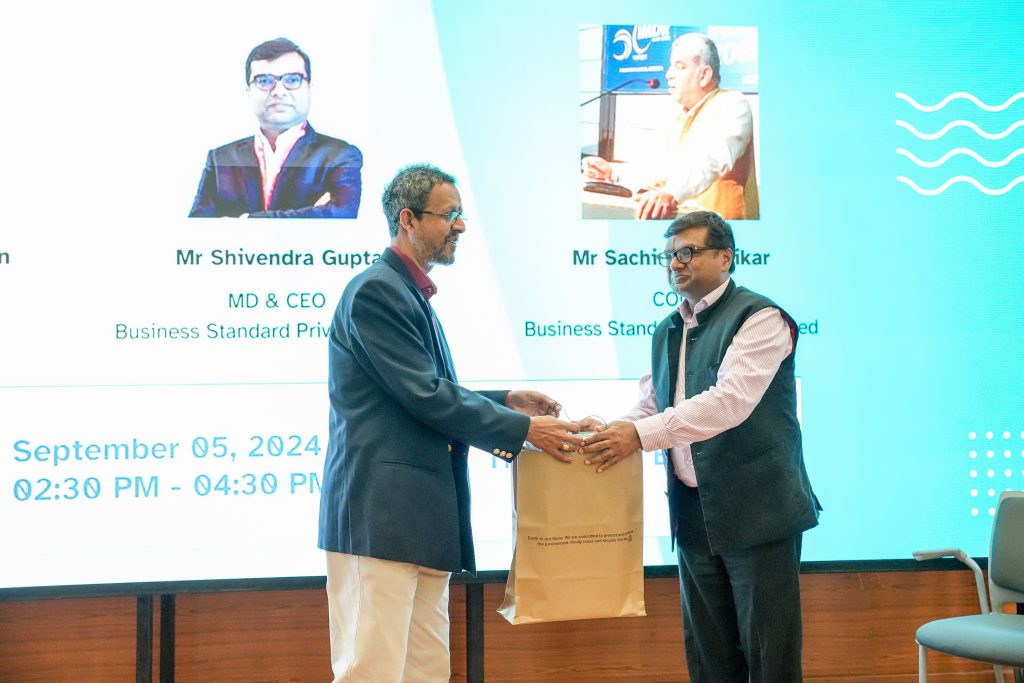 Paari School of Business’s “Insights and Perspectives” initiative featured an interactive discussion with three domain experts: Prof. Bharadhwaj Sivakumaran, Dean of PSB; Mr Shivendra Gupta, MD & CEO of Business Standard Private Ltd; and Mr Sachin Phaniskar, Chief Operating Officer of Business Standard Private Ltd, engaging with luminaries.
Paari School of Business’s “Insights and Perspectives” initiative featured an interactive discussion with three domain experts: Prof. Bharadhwaj Sivakumaran, Dean of PSB; Mr Shivendra Gupta, MD & CEO of Business Standard Private Ltd; and Mr Sachin Phaniskar, Chief Operating Officer of Business Standard Private Ltd, engaging with luminaries.The event aimed to offer practical leadership guidance and valuable insights for professional development from experienced personnel in the academic and corporate sectors. The initiative facilitated discussions with prominent figures to emphasise the importance of improving decision-making skills, interpersonal abilities, and technological proficiency. Participants were urged to seize opportunities for growth, leverage their strengths, work on areas needing improvement, and adopt a forward-thinking mindset. Additionally, the conversation highlighted key leadership principles, including effective delegation, creating a lasting impact, and turning challenges into strategic advantages.
Participants were also encouraged to focus on long-term goals, experience the complete lifecycle of projects, and understand the value of delegation and legacy-building in leadership. The conversation highlighted key themes such as turning challenges into opportunities, understanding the difference between ideation and business execution, and the importance of humility in achieving success. Overall, the event provided attendees with practical takeaways to apply in their leadership journey and a deeper understanding of the evolving demands in today’s business landscape.
Continue reading → - MoU Signed with Programming Hub for Launching AI-Powered Marketing Programme September 18, 2024
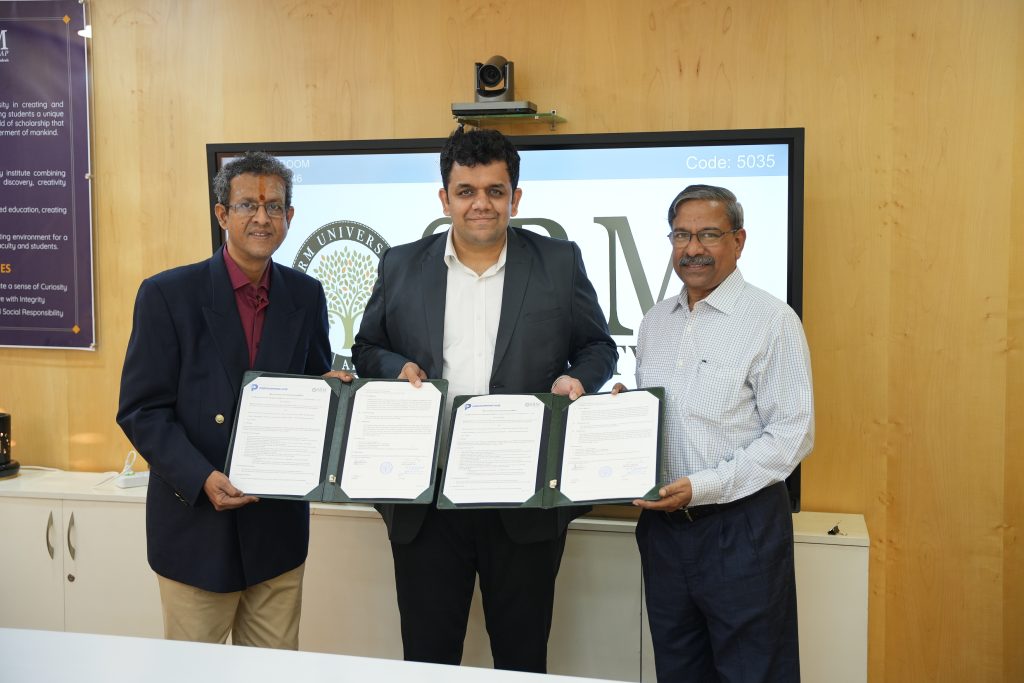
SRM University-AP inks an MoU with the EdTech Company, Programming Hub, to explore the possibility of integrating AI-powered marketing into the academic curriculum, facilitating a new age of empowered marketers. The MoU was signed by Mr Siddhesh Joglekar, CEO of Programming Hub, and Dr R Premkumar, Registrar, in the presence of Prof. Bharadhwaj Sivakumaran, Dean – Paari School of Business and the faculty of the school.
The MoU between the two organisations will assimilate AI-powered Marketing into the teaching pedagogy of the business programmes offered at Paari School of Business to bridge the gap between academia and industry. The association will also ensure the launch of AI-powered marketing programmes at Paari School of Business for prospective students in collaboration with Programming Hub. The partnership will also launch a 120-hour part-time weekend-only world-class certification programme in AI and Marketing.
“With marketing becoming an all-encompassing and essential aspect of business, AI will be the catalyst that supercharges the field of marketing, further boosting businesses into national and international domains. With AI as the key tool, marketing will be the intersection of various domains of science, technology, humanities, entrepreneurship and management”, stated Mr Siddhesh Joglekar, elucidating on the significance of AI-powered marketing on the current business landscape.
Prof. Bharadhwaj Sivakumaran, Dean of Paari School of Business, commented on this constructive collaboration, which will revolutionise the face of marketing in India. “By integrating AI-powered marketing with human-powered marketing, the pace of marketing will swiftly change, shifting students from skilled marketers to skilled decision makers. The AI-powered marketing programme will provide students with the ability to adapt and use AI in diverse ecosystems,” remarked Prof. Bharadhwaj.
With AI revolutionising all realms of management, from media planning and marketing research to customer service and sales marketing, AI-powered marketing can supplement human resources to boost their strategies and guarantee quality results within a short amount of time. SRM University-AP and its management precinct, Paari School of Business, continue to expand their network, fostering collaborations with reputed companies to provide their students with innovative and constructive programmes that will make them the powerhouse of the future.
Continue reading → - A Thought-Provoking Session with Megha Thapar September 18, 2024
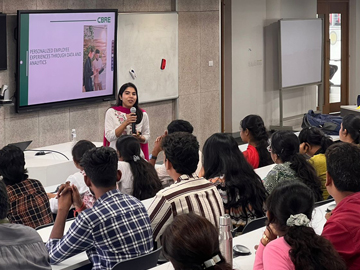 The Management precinct of the Paari School of Business had the honour of hosting an engrossing guest lecture, graced by Ms Megha Thapar, a distinguished Senior Associate Director – DEI. With an extensive 15-year career that spans the Financial Services, Retail, and Real Estate industries, Ms Thapar is renowned for her expertise in Diversity, Equity, and Inclusion (DEI). She brought invaluable insights and experiences to the forefront of this lecture, titled “Personalised Employee Experiences through Data and Analysis,” on August 21, 2024.
The Management precinct of the Paari School of Business had the honour of hosting an engrossing guest lecture, graced by Ms Megha Thapar, a distinguished Senior Associate Director – DEI. With an extensive 15-year career that spans the Financial Services, Retail, and Real Estate industries, Ms Thapar is renowned for her expertise in Diversity, Equity, and Inclusion (DEI). She brought invaluable insights and experiences to the forefront of this lecture, titled “Personalised Employee Experiences through Data and Analysis,” on August 21, 2024.The primary goal of this session was to enlighten both management students and professionals on the transformative power of data and analytics in crafting personalised employee experiences. Emphasising the critical role of DEI in the workplace, the lecture aimed to showcase how organisations could utilise data to foster more inclusive and high-performing environments. This focus was rooted in the belief that understanding and leveraging data can lead to more equitable and effective organisational practices.
Throughout the event, attendees were engaged with a series of case studies, demonstrating the practical application of data in addressing real-world HR challenges. These included analysing and interpreting key metrics to create significant business impacts. Ms Thapar guided the audience through the intricacies of identifying actionable data, extracting meaningful insights, and implementing strategies that not only enhance employee satisfaction but also bolster organisational efficiency.
The session was instrumental in equipping participants with the critical thinking skills necessary for making informed, data-driven decisions. By delving deep into how data and analytics can revolutionise the employee experience, the lecture illuminated the pathways to advancing DEI initiatives within various organisational settings. Attendees were encouraged to apply the knowledge gleaned from the case studies shared by Ms Thapar, thereby learning to employ data-driven strategies in nurturing an inclusive workplace culture, boosting employee engagement, and aligning with broader organisational objectives.
As the lecture concluded, the outcomes were profoundly impactful. Participants left with a deeper understanding of the role of data in transforming employee experiences and driving DEI efforts. They gained practical knowledge on leveraging data to tackle real-world HR and DEI challenges effectively. Furthermore, the insights into interpreting data, understanding employee behavior, and identifying actionable insights empowered them to initiate meaningful changes within their organisations. Armed with these skills, they are now better positioned to weave DEI principles into their organisational fabric, using data to tailor solutions and foster a more inclusive, equitable work environment. This event not only highlighted the critical importance of analytics in creating dynamic, authentic, and diverse teams but also fostered a greater appreciation for the strategic use of data in achieving high-performance organisational outcomes.
Continue reading → - A Helping Hand: Pro-Chancellor Donate Rs. 3 crores to CM’s Flood Relief Fund September 14, 2024
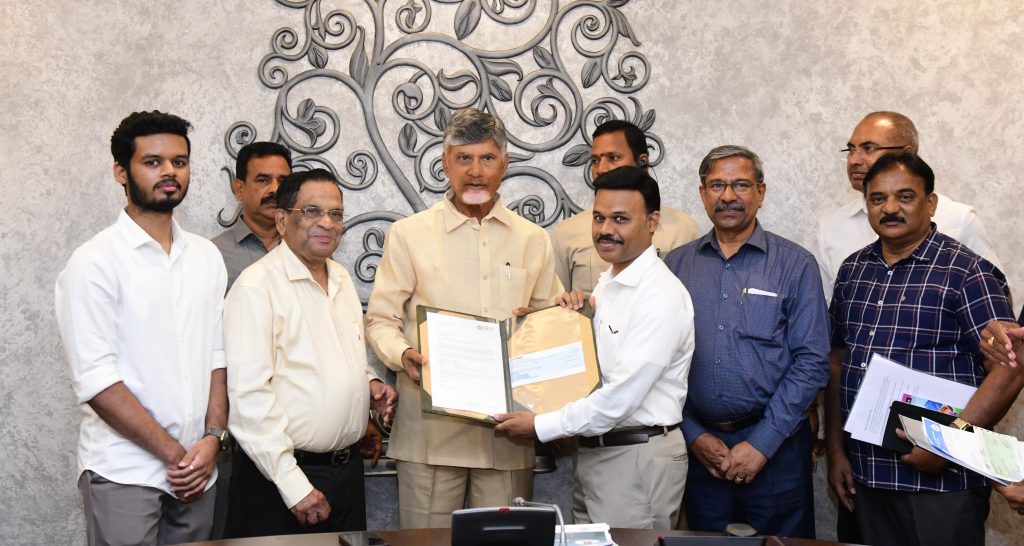
Pro-Chancellor of SRM University-AP, Dr P Sathyanarayanan, has contributed Rs. 3 crores as financial aid to the Chief Minister’s Relief Fund to help rehabilitate and reconstruct the drastically affected areas by the recent floods. The leadership team of the university, including Trustee Shri Balaji Sathyanarayanan, Executive Research Head of SRM Group Prof. D Narayana Rao and Registrar Dr R Premkumar, handed over the cheque to the honourable Chief Minister of the state Shri Nara Chandrababu Naidu at the AP Secretariat.
“It is in the very fabric of humankind to help others who are in need of safety, security and shelter. We at SRM University-AP stand with the state of Andhra Pradesh at this dire hour and will extend our extensive support towards the rehabilitation projects”, stated Dr Sathyanarayanan. Honourable CM Shri Nara Chandrababu Naidu expressed his gratitude for the magnanimous contribution of the university patron.
SRM University-AP also distributed food parcels and other amenities to the flood victims. The distribution program was initiated by Pro-Chancellor Dr P Sathyanarayanan and conducted under the aegis of the Vice Chancellor of the university, Prof. Manoj K Arora. Food packets worth Rs.10 lakh, water bottles, fruits, bread and biscuits were distributed in Gollapudi, Singh Nagar and Vambay Colony areas of Vijayawada.
Continue reading → - Dr Nilakantha Meher’s Research Uses Light to Improve Object Detection Precision September 5, 2024
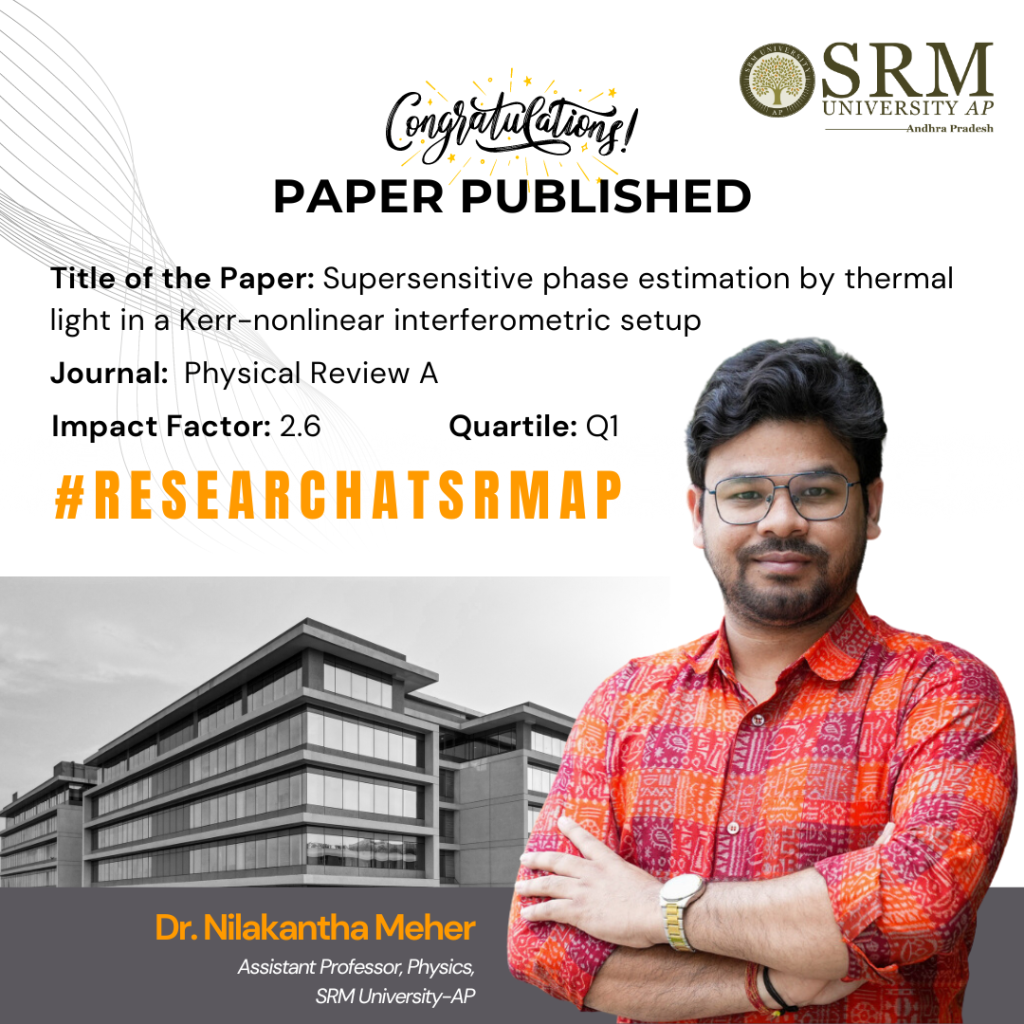
Dr Nilkantha Meher, an Assistant Professor in the Department of Physics at SRM University-AP, has significantly contributed to science with his research paper on using thermal light to detect objects with unmatched precision. This phenomenal work that featured in the journal Physical Review A will positively contribute to the fields of sensing, gravitational wave detection, and phase microscopy.
Abstract:
Estimation of the phase delay between interferometer arms is the core of transmission phase microscopy. Such phase estimation may exhibit an error below the standard quantum (shot-noise) limit, if the input is an entangled two-mode state, e.g., a N00N state. We show, by contrast, that such supersensitive phase estimation (SSPE) is achievable by incoherent, e.g., thermal, light that is injected into a Mach-Zehnder interferometer via a Kerr-nonlinear two-mode coupler. The phase error is shown to be reduced below, being the mean photon number, by thermal input in such interferometric setups, even for small nonlinear phase-shifts per photon pair or for significant photon loss. Remarkably, the phase accuracy achievable in such setups by thermal input surpasses that of coherent light with the same. Available mode couplers with giant Kerr nonlinearity that stems either from dipole-dipole interactions of Rydberg polaritons in cold atomic gas or from cavity-enhanced dispersive atom-field interactions may exploit such effects to substantially advance the interferometric phase microscopy using incoherent, faint light sources.
Practical Implementation:
The proposed nonlinear interferometer in this research can serve as a robust quantum sensor, making it suitable for a range of applications, including object sensing, gravitational wave detection, and phase microscopy.
Your Collaborations:
Prof. Gershon Kurizki (Weizmann Institute of Science, Israel)
Prof. Tomas Opatrny (Palacky University, Czech Republic)
Dr. Eilon Poem (Weizmann Institute of Science, Israel)
Prof. Ofer Firstenberg (Weizmann Institute of Science, Israel)Future Research Plans:
He is currently investigating the sensing of quantum entanglement and generating highly nonclassical states using various nonlinear interferometers. This research has significant implications for distributed quantum communication and quantum information processing.
Continue reading → - Paper on Deciphering Oxygen Evolution Reaction Activity: A QM/ML Approach with Single Atom Catalysts September 5, 2024
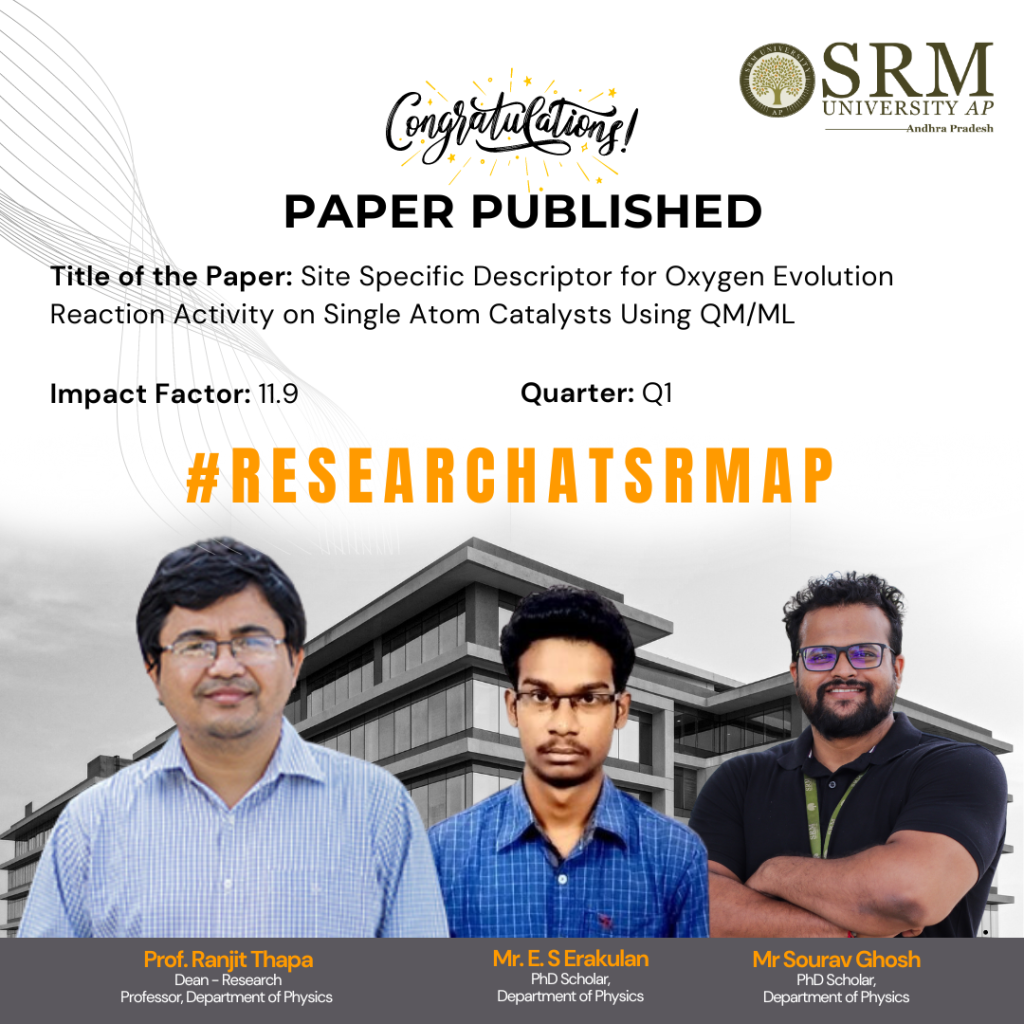
Prof. Ranjith Thapa in collaboration with two of his research scholars, Mr E. S. Erakulan Mr Sourav Ghosh and has come up with a groundbreaking research that has resulted in the publication of a scholarly paper titled, Specific Descriptor for Oxygen Evolution Reaction Activity on Single Atom Catalysts Using QM/ML.
Abstract of the paper
Descriptors are properties or parameters of a material that is used to explain any catalytic activity both computationally and experimentally. Such descriptors aid in designing the material’s property to obtain efficient catalyst. For transition metals, d-band center is a well-known descriptor that shows Sabatier type relation for several catalytic reactions. However, it fails to explain the activity when considering same metal active site with varying local environment. To address this, density functional theory was used for single atom catalysts (SACs) embedded on armchair and zigzag graphene nanoribbons (AGNR and ZGNR). By varying the anchoring nitrogen atoms’ orientation and considering pristine and doped cases, 432 active sites were used to test the oxygen evolution reaction (OER) activity. It was observed that S and SO2 dopant helps in reducing the overpotential on Co-SAC (h = 0.28 V). Along with the d-band center, a total of 105 possible descriptors were individually tested and failed to correlate with OER activity. Further, PCA was employed to narrow down unique descriptors and machine learning algorithms (MLR, RR, SVR, RFR, BRR, LASSO, KNR and XGR) were trained on the two obtained descriptors. Among the models, SVR and RFR model showed highest performance with R2 = 0.89 and 0.88 on test data. This work shows the necessity of a multi-descriptor approach to explain OER catalytic activity on SAC and the approach would help in identifying similar descriptors for other catalytic reactions as well.
Social Implications:
Computational studies have proven to be a vital tool to predict new materials and also assess the behaviour towards various catalytic reactions. They also identify the innate properties of the material which drives the catalytic activity. It helps in designing the material with required property to improve the catalytic activity. Descriptors are such computationally obtained properties/parameters of a material that has a meaningful relation with any catalytic property of a chemical reaction. d-band center, given by Hammer and Norskov in 1995, explained the binding strength of oxygen atom on pure transition metals. The d-band center shows Sabatier type relation with chemical activity and has been widely used to explain the catalytic activity of several reactions since its formulation. The adsorbate state after interaction with delocalized s-states of the metal atom is almost constant while that resulting from d-states interaction, is split into bonding and antibonding states. Hence the s-states were not considered. It is well known that, when the dimensions of a system are lowered the states become narrow and localized. In such systems, the d-band center does not explain the catalytic activity well and it is an open research problem.
Future Projects:
Density functional theory with machine learning approach could further be used and improved on similar SACs from which a predictive model equation could be constructed. Also, the proposed models are open to exploration on other catalytic reactions as well.
The authors thank SRM University-AP and National Super Computing mission for providing the computational facility.
Continue reading → - Enhancing Visual Saliency in Group Photographs: A Novel Approach for Improved Security and Healthcare Applications September 5, 2024
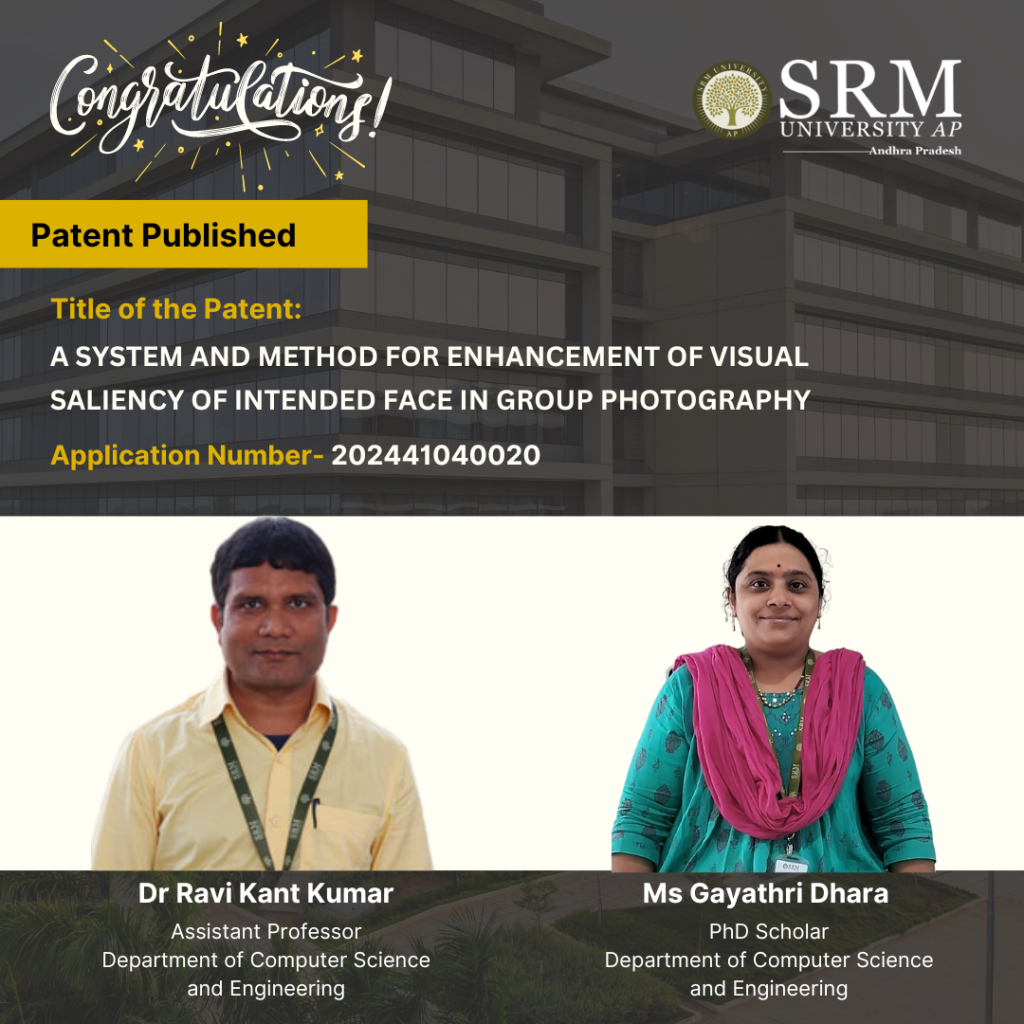
Dr Ravi Kant Kumar, an Assistant Professor at the Department of Computer Science and Engineering, and his research scholar, Ms Gayatri Dhara, have come up with a patent titled “A System and Method for Enhancement Of Visual Saliency Of Intended Face In Group Photography.” The patent, with Application Number 202441040020, employs pathbreaking technology to enhance security and healthcare applications, with real-time face recognition and remote diagnostics.
Abstract:
Visual saliency is a way of figuring out which parts of a scene draw our attention the most. When looking at a crowd or a group of faces, our eyes naturally focus more on certain faces than others. This happens because some faces have dominant features that stand out more. For faces that don’t naturally catch our attention, there is a need to make them more noticeable. This new method and system are designed to do just that. The system calculates scores based on various factors like skin tone, colour, contrast, position, and other visual details. These scores help identify which face needs enhancement, making it more prominent in a group of faces. The primary advantage of this invention is its potential to improve user experience in various applications, such as photo editing, social media, security systems, and more. By giving users, the control to select and enhance a specific face, it allows for a more personalised and targeted approach to face recognition and enhancement. This could be particularly beneficial in scenarios where the user wants to highlight a specific individual in a group photo or in a crowd. Overall, this invention represents a significant advancement in the field of face recognition and image enhancement, offering a novel and user-centric approach to visual saliency. It opens up new possibilities for user interaction and control in image editing and face recognition technology.
Practical and Social Implications
The practical implementation of this research lies in its ability to identify and enhance faces within a group or crowd that do not naturally draw attention. This innovative method and system address this issue by calculating saliency scores based on factors such as skin tone, colour, contrast, position, and other visual details. These scores are then used to identify faces that need enhancement to become more prominent in a group. The system’s ability to enhance specific faces has significant practical applications in several fields.
Photo Editing: Users can easily enhance specific individuals in group photos, ensuring that everyone stands out as desired. This is particularly useful for personal photos, event photography, and professional photo editing.
Social media: Enhanced face recognition and saliency can improve user experience by allowing users to highlight specific people in their posts, making photos more engaging and personalised.
Security Systems: In surveillance and security applications, the ability to enhance less prominent faces can improve the accuracy of face recognition systems, aiding in the identification of individuals in crowded or low-visibility conditions.
Collaborations:
SRM University-AP,
Dr Ravi Kant Kumar,
Mrs Gayathri Dhara.Future Research Plans:
Future plans for this visual saliency-based face enhancement system include refining algorithms for greater accuracy and efficiency, and integrating with popular photo editing software and social media platforms for seamless user experience. The technology will be expanded into security and healthcare applications, enhancing real-time face recognition and remote diagnostics. Emphasis will be placed on reducing biases, ensuring privacy protection, and enabling user customisation. Collaborations with academic institutions will drive further research, while commercialisation efforts will focus on launching products globally.
Continue reading → - Dr Negi’s Research Exploration of the Sugeno Exponential Function and Its Multidisciplinary Applications September 5, 2024
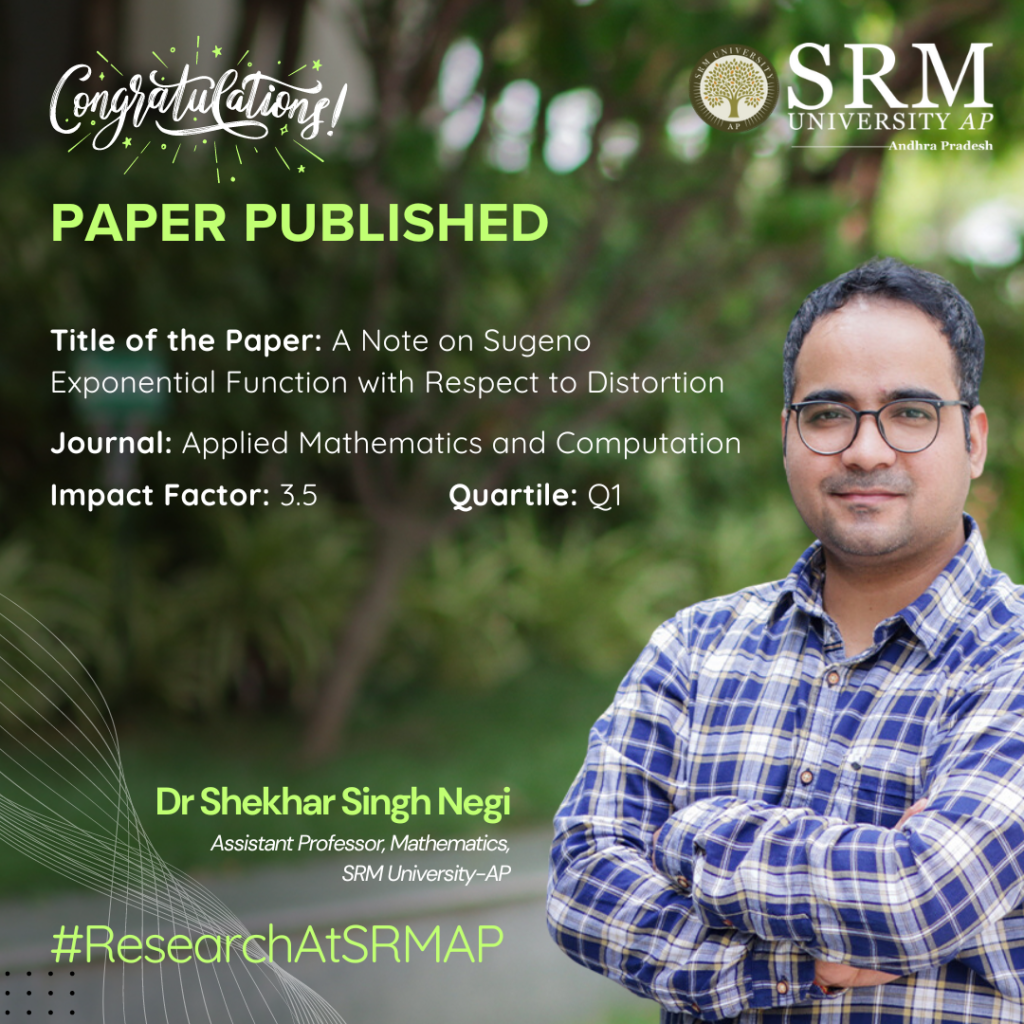
Dr Shekhar Singh Negi from the Department of Mathematics has published a research paper titled “A note on Sugeno exponential function with respect to distortion.” Dr Negi’s research investigates the Sugeno exponential function. This research develops new mathematical tools and rules to work with a different way of measuring things, which can be useful in various fields like economics, biology, or any area where traditional measurements don’t quite fit the problem at hand.
Abstract:
This study explores the Sugeno exponential function, which is the solution to a first order differential equation with respect to nonadditive measures, specifically distorted Lebesgue measures. We define k-distorted semigroup property of the Sugeno exponential function, introduce a new addition operation on a set of distortion functions, and discuss some related results. Furthermore, m-Bernoulli inequality, a more general inequality than the well-known Bernoulli inequality on the real line, is established for the Sugeno exponential function. Additionally, the above concept is extended to a system of differential equations with respect to the distorted Lebesgue measure which gives rise to the study of a matrix m-exponential function.
Finally, we present an appropriate m-distorted logarithm function and describe its behaviour when applied to various functions, such as the sum, product, quotient, etc., while maintaining basic algebraic structures. The results are illustrated throughout the paper with a variety of examples.
Collaborations:
Prof. Vicenc Torra, Professor at the Department of Computing Science at Umea University. His area of research include artificial intelligence, data privacy, approximate reasoning, and decision making.
Future Research Plans:
To explore the aforementioned derivative and investigate results with applications in real life.
Continue reading →


